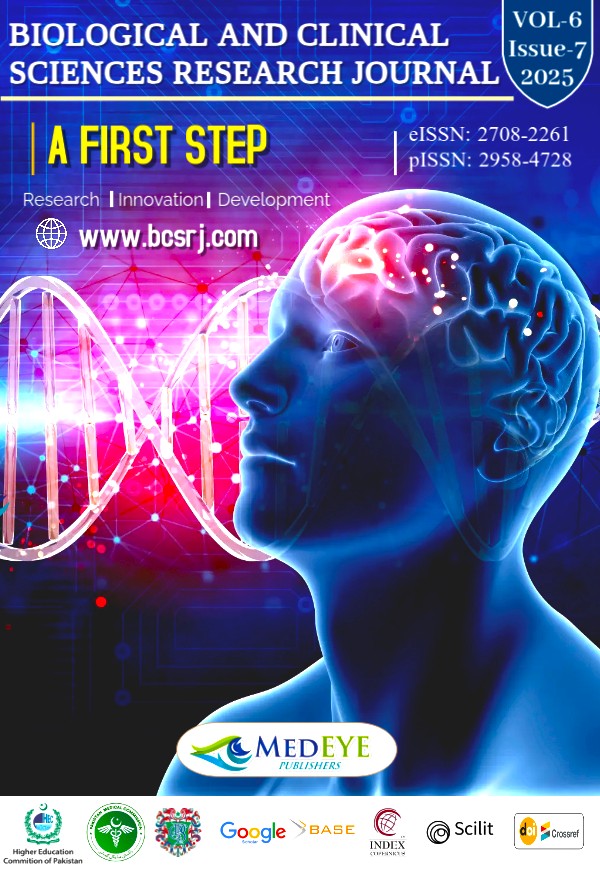Hair and Nail Lead Concentrations in Leather-Industry Workers Compared with Community Controls: A Cross-Sectional Study
DOI:
https://doi.org/10.54112/bcsrj.v6i7.1908Keywords:
Bioaccumulation, Hair, Lead, Nails, Occupational Exposure, PakistanAbstract
Occupational exposure to lead (Pb) remains a serious global public health concern, particularly in leather manufacturing, where workers are chronically exposed to toxic substances. Hair and nail matrices serve as reliable biomarkers for assessing long-term lead accumulation. Objective: To compare hair and nail lead concentrations between leather-industry workers and community controls in Sialkot, Pakistan. Methods: This analytical cross-sectional study was conducted on 80 adults, including 40 leather workers and 40 age- and sex-matched non-exposed controls. Hair and nail samples were collected, washed, decontaminated, and digested with nitric and hydrochloric acids before analysis with inductively coupled plasma–optical emission spectrometry (ICP-OES). Mean concentrations (µg/g) were compared using two-sided statistical significance testing, with p<0.05 considered significant. Results: Hair lead levels were significantly higher among workers than controls (0.3300 ± 0.6589 vs −0.0462 ± 0.0543 µg/g; p=0.0056). Similarly, nail lead concentrations were elevated in workers compared with controls (0.2662 ± 0.6521 vs −0.0240 ± 0.1002 µg/g; p=0.0067). The highest hair and nail lead concentrations were observed in workers aged 51–53 years (2.06 µg/g) and 55–60 years (2.91 µg/g), respectively. Lead concentrations showed a positive correlation with years of employment, indicating progressive bioaccumulation. Conclusion: Leather-industry workers exhibited significantly higher hair and nail lead concentrations compared with community controls, reflecting chronic occupational exposure. These findings emphasize the importance of routine biomonitoring, adequate protective measures, and enforcement of stricter occupational health and safety regulations in Pakistan's leather industry.
Downloads
References
Yadav S., Patil G., Virmagami A., Bijalwan V., Devi K., Chauhan A.et al.. Occupational lead exposure is an independent modulator of hypertension and poor pulmonary function: a cross-sectional comparative study in lead-acid battery recycling workers. Toxicology and Industrial Health 2022;38(3):139-150. https://doi.org/10.1177/07482337221076248
Yu Y., Thijs L., Wei D., Melgarejo J., Yu C., Yang W.et al.. Two-year responses of renal function to first occupational lead exposure. Kidney International Reports 2022;7(6):1198-1209. https://doi.org/10.1016/j.ekir.2022.03.014
Abdraboh A. Related health hazards with occupational exposure to cadmium and lead during spray painting in car and furniture workshops. Journal of Environmental Sciences Mansoura University 2023;0(0):0-0. https://doi.org/10.21608/joese.2023.223932.1027
Mariem N., Bani M., Dorra E., Magroun I., Chiraz H., & Hamrouni B.. Effectiveness of hair lead concentration as a biological indicator of environmental and professional exposures. JMR 2020:11-14. https://doi.org/10.32512/jmr.3.2.2020/11.14
Malara P., Misiołek M., Fischer A., & Malara B.. The influence of environmental exposure to heavy metals on the occurrence of selected elements in the maxillary bone. International Journal of Molecular Sciences 2023;24(3):2552. https://doi.org/10.3390/ijms24032552
Abasilim C., Shannon B., Madigan D., & Friedman L. Medical surveillance of occupational lead exposure using the EPA's Toxics Release Inventory and Adult Blood Lead Epidemiology and Surveillance Program: Illinois, 2016–2023. American Journal of Industrial Medicine 2025. https://doi.org/10.1002/ajim.23738
Kosnett M., Berenji M., Burton A., Durand‐Moreau Q., Esty E., Fischman M.et al.. Acoem position statement. Journal of Occupational and Environmental Medicine 2023;65(3):e170-e176. https://doi.org/10.1097/jom.0000000000002774
Namungu L., Mburu C., & Were F. Evaluation of occupational lead exposure in an informal work environment in Kenya. Chemical Science International Journal 2021:43-54. https://doi.org/10.9734/csji/2021/v30i1030265
Obeng-Gyasi E, Cumulative effects of low-level lead exposure and chronic physiological stress on hepatic dysfunction—a preliminary study. Medical Sciences 2020;8(3):30. https://doi.org/10.3390/medsci8030030
Ruebner R., Hooper S., Parrish C., Furth S., & Fadrowski J. Environmental lead exposure is associated with neurocognitive dysfunction in children with chronic kidney disease. Pediatric Nephrology 2019;34(11):2371-2379. https://doi.org/10.1007/s00467-019-04306-7
Hussain S., Khanam T., Ullah S., Aziz F., Sattar A., Hussain I.et al.. Assessment and Exposure Analysis of Trace Metals in Different Age Groups of the Male Population in Southern Punjab, Pakistan. Toxics 2023;11(12):958. https://doi.org/10.3390/toxics11120958
Bansal O.. The concentration of the potentially toxic metals in human hair, nails, urine, blood, and air, and their impact on human health: a review. European Journal of Theoretical and Applied Sciences 2023;1(2):185-216. https://doi.org/10.59324/ejtas.2023.1(2).18
Firkey M., Tully L., Bucci V., Walsh M., Maisto S., Hahn J.et al.. Feasibility of remote self‐collection of dried blood spots, hair, and nails among people with hiv with hazardous alcohol use. Alcohol: Clinical and Experimental Research 2023;47(5):986-995. https://doi.org/10.1111/acer.15063
Komatsu H., Inui A., Odmaa E., Ito Y., Hoshino H., Umetsu S.et al.. Signature of chronic hepatitis B virus infection in nails and hair. BMC Infectious Diseases 2022;22(1). https://doi.org/10.1186/s12879-022-07400-8
Saeed T., Abbasi N., Zahid M., Noor F., Ullah K., & Khokhar M. Toxicological profile and potential health concerns through metals and trace elements exposure in brick kiln workers from Lahore, Pakistan. Environmental Geochemistry and Health 2024;46(5). https://doi.org/10.1007/s10653-024-01937-0
Downloads
Published
How to Cite
Issue
Section
License
Copyright (c) 2025 Amina Tahir, Saima Ashraf, Muhammad Awais, Urwa Tul Esha, Sadia Ashraf, Abida Shahzadi, Adeel Khalid

This work is licensed under a Creative Commons Attribution-NonCommercial 4.0 International License.








